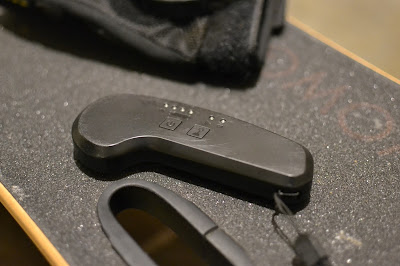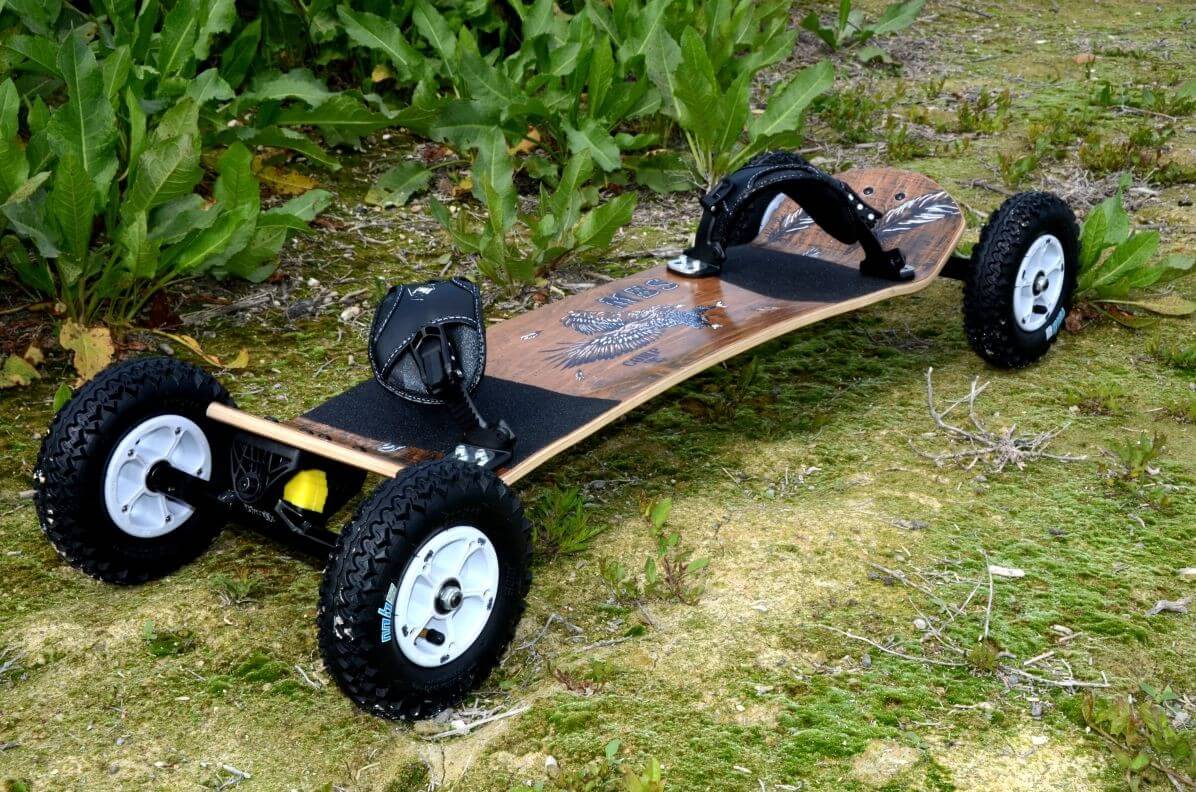Electric Mountainboard Build Part 1: Planning
 |
| My OG board, the Wowgo 2S |
Most longboards are great on road for getting around. However, as soon as you get any sort of rough roads or terrain, you're pretty much screwed. Enter the mountainboard, with massive trucks, pneumatic tires, and bindings. However, they're pretty much limited to downhill runs, because it's nearly impossible to push on them due to the ground clearance and bindings. Electrification makes them far more practical, and they're the perfect platform for off road and trail riding. My current Wowgo 2S is pretty limited in terms of performance and capabilities, so I wanted a new board. This marks the start of my build process, and I expect it to be completed in roughly six months, just in time for the season to begin. This is subject to change based on availability and just overall plans.
 |
| Example of a mountainboard, an MBS Comp 95 "Birds" |
Considerations
There's a few different options available now for AT boards, so why did I choose to go DIY? The first reason was that I wanted channel trucks. Almost all of the "budget" AT boards out there currently use DKP trucks, which I didn't like. Channel trucks are much stronger and wider, which is much better suited for off road use. Second is the price for capability. Options like the Backfire Ranger and Wowgo AT are good for bad roads and gravel, but aren't particularly well suited for actual off road and trails. They are also in the $1k mark, and once you get towards that level, DIY starts becoming a better value.
There's also high end boards with pneumatic tires, such as the Flux AT, Kaly XL, and Lacroix Nazare, but those are designed for the road. I have no doubt they will crush a mountainboard in the on road experience, but that wasn't what I was looking for. So far, the only prebuilt true off road board in my price range I could find was the Trampa, but it is still very expensive, and ships from across the pond. Thus, I decided to go with a DIY build.
Inspiration
My build was based off of several other similar builds I have seen, and some of the parts have been tried and true. All of these images are credited to the original poster in the captions.
 |
| Skatemetric's Patriot build |
 |
| MadMaxDK's build |
 |
| Saturn_Corp's build |
I originally looked at the Patriot build, since it was one of the least expensive and best documented builds with full tutorials and everything. However, I was hesitant on getting some of the critical components from an unknown source, and while they didn't have any issues with them, I preferred a more tried and tested brand for critical components such as the trucks. I then started looking at MBS and Trampa builds, as they tend to be the main brands used for these boards. MBS was far cheaper, but required DIY since they don't really offer any electric boards just yet. With price being the main factor, I decided to go with MBS.
After looking at some builds online, there were definitely a few features I liked. I wanted a battery box mounted on the top of the board, as it would get scratched too easily on the bottom and reduce ground clearance. It does limit your foot positioning, but with bindings you're being limited anyways. A rear box for the ESC seemed like the way to go as well. Motors would have to be mounted outboard, and I liked the higher angle ones as they keep it away from debris kicked up by the tires better. I liked the Summerboard style bindings in the third picture since they seem easier to bail out of, but I wasn't sure how to route the cable from the battery box to the ESC then since other MBS builds routed it on top of the rear binding.
Core Platform
The base for this build will be an MBS mountainboard. I'm currently deciding between the MBS Comp 95 "Birds" and the Pro 95 "DW" completes. This will provide the deck, Matrix II trucks, four wheels and tires, and the bearings and bushings needed, and is considerably cheaper than buying them all separately. I am still considering whether to upgrade to the metal truck hangars, which are included as standard on the Comp 95. In addition, the Comp 95 has a stiffer and slightly shorter deck, but I am not sure if it is worth the extra $100 premium since I won't be doing jumps and bottoming it out.
Drivetrain
The drivetrain is still subject to change, but I think I have the basic idea down. Since this will be a mountainboard, traction offroad will actually matter, so I will be doing a dual drive setup. My plan is to use a chain drive, as belts seem too fragile for offroad use, and gear drives are too expensive right now. Chain seems like a good medium, although it definitely is louder than the other two options. Spare chains and sprockets are relatively easy to procure, unlike gears. My plan is to use the Momentum Chain Drive Set, which consists of a 12T motor sprocket and 62T wheel sprocket. They will be mounted using some Boardnamics Matrix II Motor Mounts, which should yield enough distance for the chain. Currently, the motors are still up in the air, but I'm currently thinking about either the Flipsky 6374 170kv motors or the Maytech 6374 170kv motors. They should offer enough performance for my liking, although there's plenty of space to upgrade to 6384 or even 63100 motors in the future if need be.
Electrical
Electrical is probably the least set in stone at the moment, due to a lack of reputable budget ESCs out there in the market. The ones I am currently looking at are the Spintend 75V/200A Ubox and the Torqueboards v6 ESC, although the Ubox is currently getting a shakedown on the forums, and the Torqueboards ESC is not yet available for purchase. I also considered the Lacroix Stormcore 60D, but that was slightly too high in price for my build. The Ubox comes with its own remote, but the others will be paired with a Flipsky VX1 remote and receiver module. There isn't a screen like the VX2, but it's cheap and tested. Having been used to the original Hobbywing remote, it's not like I'm losing any features anyways.
Batteries are somewhat easier. Since I don't have a spot welder, I have decided to not go with a 21700 battery pack and stick with premade LiPos. Having someone else build the batteries was also an option I explored, but it would have increased the price by at least 50% for a 12S4P battery, which would be getting half the range and power in exchange for longevity and charging ease. The current design calls for four Tattu 14Ah 6S 25C pack, although I will need to find a way to convert the AS150 plugs to an XT90 or similar. They will be connected in series and parallel to form a 12S2P setup. According to this calculator, this should provide me anywhere from 20-40 miles of range, depending on motor efficiency. There's too many variables at this point for me to know true range, but it will for sure be higher than what I'm getting out of my current board. Alternatively, I am thinking about doing a simple 12S1P setup with just two batteries to save weight, and alternate between the two pairs since it should be enough for most rides.
Hardware
There's a few specific pieces of hardware that are important for this build. The literal and figurative big one is the enclosure to put the electronics in. I have decided to use a Pelican style box to top mount the batteries in, and so far the Monoprice 6.6L Weatherproof Case seems to fit both the bill and the batteries. For the ESC mounted in the back, I need to first choose a suitable ESC to get the proper sizing, but my thought is something like the Apache 550 should be large enough to hold it. I may even design my own rear enclosure to allow for better cooling and a heatsink, but that will be decided later based on the ESC performance.
To attach these enclosures onto the board, I am thinking about going with Velcro. My original plan was to bolt them onto the board and use rubber standoffs to account for any vibrations and board flex, but after seeing builds using velcro, it seemed strong enough for my purposes. In addition, it means that I don't have to drill any holes in the board, which is a huge plus.
I also plan on carrying a spare wheel on top of the ESC case for easier changes if a tire goes flat, so that is an extra cost.
Cost Breakdown
The total cost will vary by sales, but overall the project will be roughly $1500. Most of it goes towards the main components. The core board will be $400, and the batteries another $400. The ESCs are a big variable at this time, and will be between $200 and $400. Motors are a little cheaper, in the $120-200 range. The motor mounts and chain drive will be close to $200. Everything else are small costs that add up, including shipping and taxes.
Next Steps
The next step is to finalize the parts list and start gathering them for the build. Some things can be bought anytime, like the core board and mounts, while others will need to wait based on availability. I'm definitely planning on taking advantage of any sales that will happen around the holidays. Plans are likely to change in the coming weeks, so some of this might not even be relevant in later updates. It will definitely be an interesting project coming over the next six months!
For the next part, click here!



Comments
Post a Comment